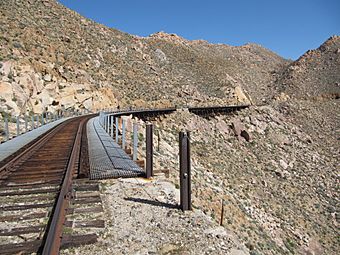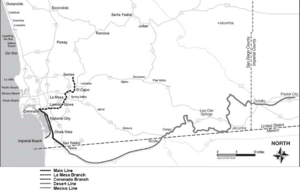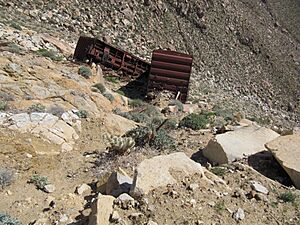San Diego and Arizona Eastern Railway facts for kids
 |
|||

Carrizo Gorge trestle
|
|||
| Overview | |||
|---|---|---|---|
| Current operator | San Diego and Imperial Valley Railroad, Pacific Southwest Railway Museum | ||
| Parent company |
|
||
| Headquarters | James R. Mills Building 1255 Imperial Avenue San Diego, California |
||
| Reporting mark | SDAE | ||
| Locale | California and Mexico | ||
| Dates of operation | 1932–present | ||
| Predecessor | San Diego and Arizona Railway | ||
| Technical | |||
| Track gauge | 4 ft 8 1⁄2 in (1,435 mm) standard gauge | ||
|
|||
The San Diego and Arizona Eastern Railway (SDAE) is a railway line in the United States. It was started in 1932. This railway took over from the San Diego and Arizona Railway (SD&A). That earlier railway was created in 1906 by a businessman named John D. Spreckels.
Many engineers at the time called this railway "The Impossible Railroad." This was because it was very hard to build. The main goal was to give San Diego a direct train connection to the east. It did this by linking up with the Southern Pacific Railroad lines in El Centro, California. Since 1979, the San Diego and Arizona Eastern Railway has been owned by the San Diego Metropolitan Transit System.
Railway Lines
At its busiest, the original SD&A railway stretched about 146.4 miles (235.6 km). It went from San Diego all the way to El Centro. Today, the San Diego and Arizona Eastern Railway (SDAE) uses about 108 miles (174 km) of those original tracks. These tracks are split into four main parts:
- Main Line: This part runs for 15.5 miles (24.9 km). It goes from downtown San Diego south to San Ysidro. The San Diego Trolley's Blue Line also uses these tracks.
- La Mesa Branch: This section is 16.1 miles (25.9 km) long. It goes east to the city of El Cajon. The San Diego Trolley's Orange Line uses this part too.
- Coronado Branch: This line is currently not used. It splits from the Main Line in National City. It then runs 7.2 miles (11.6 km) south to Imperial Beach.
- Desert Line: This part has not been used since 2008. It runs for 69.9 miles (112.5 km). It stretches from the Mexico–United States border near Tecate to Plaster City.
History of the Railway
The story of the San Diego and Arizona Eastern Railway began on December 14, 1906. That's when John D. Spreckels announced his plan. He wanted to build the San Diego and Arizona Railway (SD&A). This railway would connect San Diego directly to the east. It would link up with the Southern Pacific (SP) lines in El Centro, California. Spreckels had a secret agreement with SP to help pay for the project. Construction on the line started on September 7, 1907.
In 1909, the SD&A made a deal with the Mexican Government. This allowed the tracks to cross the border. As part of this agreement, the SD&A had to create the Tijuana and Tecate Railway. This new railway would build and manage a 44-mile (71 km) section of track in Mexico for 99 years.
Building the railway was very difficult. Many engineers called it "The Impossible Railroad." This was because of the huge challenges they faced. In Mexico, revolutionaries sometimes attacked the construction crews. They would try to get soldiers, take supplies, and cut telephone wires. In the U.S., the government took control of all railways in 1917. They stopped construction to save resources during World War I. Later, construction was allowed to continue. This was because the SD&A would help military bases.
The SD&A was finished on November 15, 1919. It cost about $18 million to build. But running the railway also had many problems. Heavy rains washed away parts of the track east of San Diego in 1926, 1927, and 1929. This caused money troubles for the railway. The hardest year was 1932. Floods, landslides, and fires closed three tunnels. Repairs would cost over $600,000. John D. Spreckels had passed away in 1926. His family no longer wanted to deal with the railway's financial problems. So, in 1933, they sold their share of the railway to SP.
Passenger train service on the line stopped on January 11, 1951. This was after many years of fewer and fewer passengers. On May 20, 1970, SP gave up its part of the Tijuana and Tecate Railway. It went to a Mexican national railway.
On September 10, 1976, Hurricane Kathleen caused a lot of damage. It destroyed large parts of the track and bridges east of San Diego. SP wanted to stop using the railway. But the Interstate Commerce Commission said no in 1978. The San Diego Metropolitan Transit Development Board (MTDB) then offered to buy the SD&AE for $18.1 million. This was if SP fully repaired the line. The deal was completed on August 20, 1979.
This purchase gave MTDB two sections of track that could be used for public transport. One was the SD&AE Main Line from downtown San Diego to the San Ysidro Port of Entry. This became the Blue Line of the San Diego Trolley. The other was the SD&AE La Mesa Branch from downtown San Diego to El Cajon. This became the Orange Line.
As part of the deal, SP kept the section of the Desert Line between Plaster City and El Centro. All tracks had to remain open for freight service. The board made a deal with the San Diego and Imperial Valley Railroad on March 8, 1984. This was to keep moving freight cars from the end of the Santa Fe Railway in downtown San Diego. These cars went to businesses in the San Diego area or to the Mexico–United States border in San Ysidro.
However, freight service between San Ysidro and Plaster City has been difficult. More natural disasters and the fact that the line crosses two countries have closed it several times since 1979. The line has not been used since 2008. In November 2021, the agreement with the most recent company leasing the line was ended. The Pacific Southwest Railway Museum operates on a part of the line in Campo.



